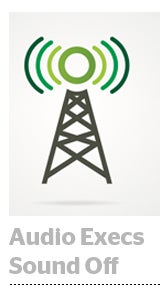 There are a number of reasons programmatic buying has yet to permeate the digital audio space, a growing area that would seem ripe for automation.
There are a number of reasons programmatic buying has yet to permeate the digital audio space, a growing area that would seem ripe for automation.
Among those reasons is a lack of standards. The IAB’s first stab at standardization was the Digital Audio Ad Serving Template (DAAST), which surfaced some six months ago. But according to those familiar with listener habits in the US, audiences are often streaming on non-IAB compliant software, or they’re downloading content rather than streaming, which has made measurement more difficult.
Though the industry is still working to adapt those guidelines, more than one digital audio executive pointed to the template as a signal of positive change.
And digital audio content is on the rise.
eMarketer predicts digital audio audiences in the US will hit 169.3 million in 2015, growing to 183.4 million in 2018. This estimate combine listeners of digital broadcasts of terrestrial radio stations, digital-only radio stations or audio podcasts on any device at least once per month.
In February, Edison Research pointed out that monthly online radio listeners now exceed half the population – 53%, to be exact – for US audiences 12 and up. And most recently, Triton Digital unveiled data suggesting that streaming audio started 2015 with a bang, up 41% year over year.
AdExchanger asked execs from Mediaocean, Triton Digital, TargetSpot and iHeartRadio to explain what’s standing in the way of programmatic advertising for digital audio content.
Click below to read their responses.
- Cordie DePascale, VP of product and partner solutions, Mediaocean
- Benjamin Masse, SVP of advertising, Triton Digital
- David Kert, chief revenue officer, TargetSpot
- Brian Kaminsky, chief operating officer, iHeartRadio
Cordie DePascale, VP of product and partner solutions, Mediaocean
“Some in the industry see programmatic audio in a negative light because of incorrect perceptions about programmatic itself. The first perception is that programmatic is for distressed, undersold, remnant inventory that spans a dizzying amount of supply sources. The second is that programmatic is only for the RTB market because of the volume of supply sources. In high-demand markets for premium audio inventory, supplied by pure plays such as Pandora and Spotify, there is little to nothing lost or wasted. The ability to guarantee premium audiences and deliver is the mainstay of pure-play digital audio today. The market is minimally dotted with premium content providers, so no inventory is left on the floor.
Radio streaming is another story, and that’s where there could be an opportunity to benefit from programmatic capabilities. There are a few concerns here. Who has access to all of that inventory and do they have the tech stack, data, and know-how to package up that audience? These questions need answers if we’re to bring programmatic to digital audio content.”
Benjamin Masse, SVP of advertising, Triton Digital
“Due to scarcity of over-IP audio ads, compared to programmatic display and video as well as over-the-air radio, the price programmatic buyers are willing to pay has not often been high enough to exceed the price that buyers in other channels are paying.
There is also still a fair amount of non-IAB-compliant software players used to listen to traditional radio streams, such as iTunes, Winamp and others, which aren’t browsers, hence hindering programmatic capabilities. That being said, the willingness of all industry players to adopt the recently released IAB DAAST standard promises to accelerate the pace of making all listeners programmatically targetable.
The US was clearly a leader in programmatic audio since the launch of a2x [Triton Digital’s audio ad exchange] over two years ago, but other markets, especially Latin America, Australia and New Zealand, are rapidly adopting programmatic audio.”
David Kert, chief revenue officer, TargetSpot
“I think there are a number of hurdles that we, the digital audio industry, have to overcome before programmatic advertising can reach the adoption that display and video has seen. Fortunately, 2014 saw measurable steps taken in overcoming some of these hurdles and both publishers and advertisers are warming up to programmatic within our space.
One of the biggest hurdles that programmatic was facing in digital audio was the lack of standardization across audio players, ad serving [methods], measurement, reporting and tags. Advertisers have sometimes had to reconcile differences across these factors within the same campaigns when working with multiple ad platforms. DAAST is addressing this issue and it’s the reason we’ve been working so closely with the IAB and other companies to help develop and evangelize it as a standard. The adoption of DAAST by ad platforms and publishers gives us the standardization necessary to build tools, like programmatic, which advertisers can use uniformly across multiple channels.
The adoption and maturity rate of digital audio advertising has grown more rapidly over the last few years than many people expected. As such, the third-party ad-serving and measurement solutions are not yet fully built to address the technological ad-serving differences of digital audio and we’ve had to adapt existing technologies that sometimes present challenges. For example, whereas most display and video content is consumed via web browsers and apps, many people listen to digital audio through portals and media players such as iTunes, Apple TV, Roku or Windows Media Player, which presents different tracking challenges. Fortunately, the high demand for digital audio has brought more attention to this topic.”
Brian Kaminsky, chief operating officer, iHeartRadio
“I don’t think anything is standing in the way. We are advocates of programmatic buying because we want it to be easier and more efficient for our clients and our sellers to transact and also optimize the solutions we provide to our advertising partners. iHeartMedia has been investing in our digital platforms, and is already engaged in digital programmatic with display.
The technology for audio is there, now it’s just a question of generating awareness and getting the buying community activated around a relatively new concept.”














